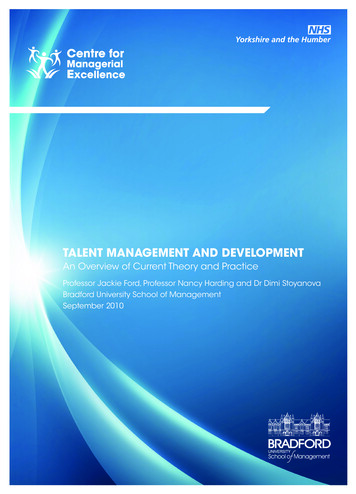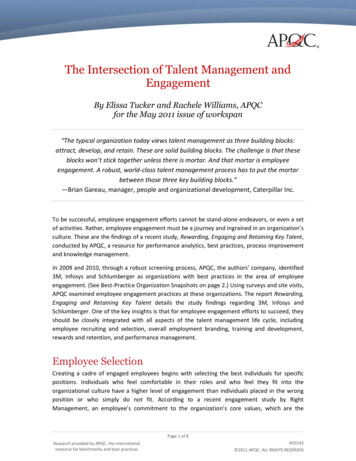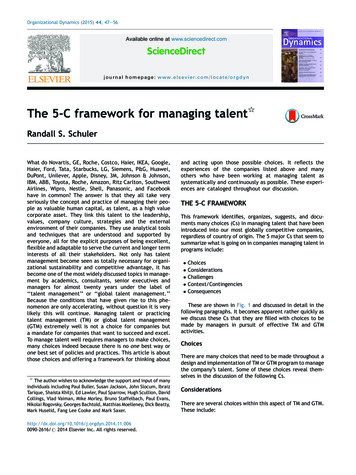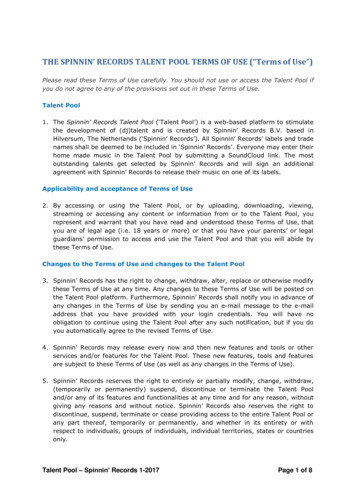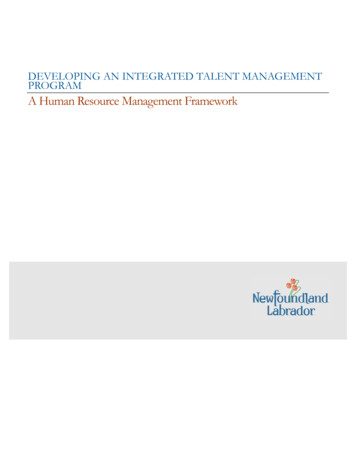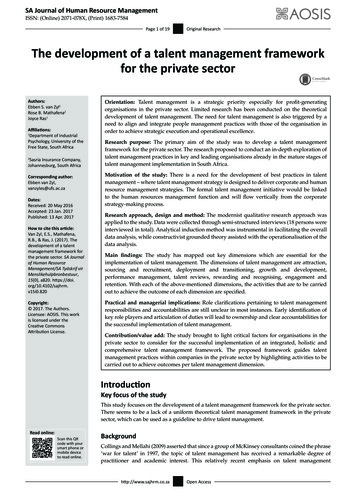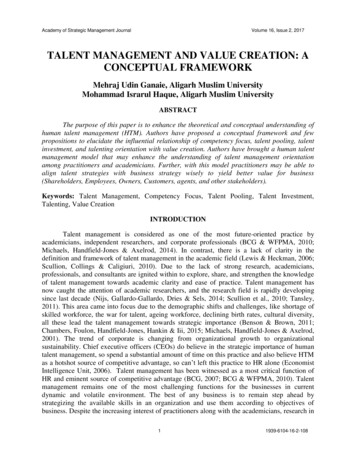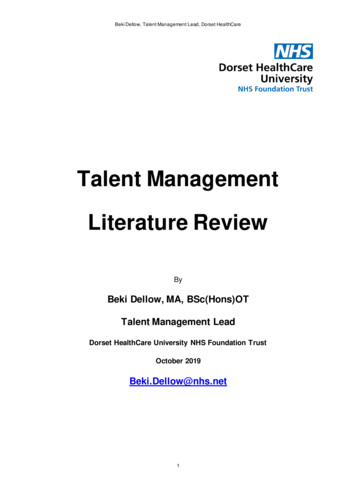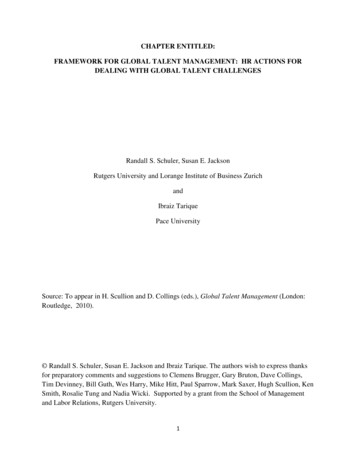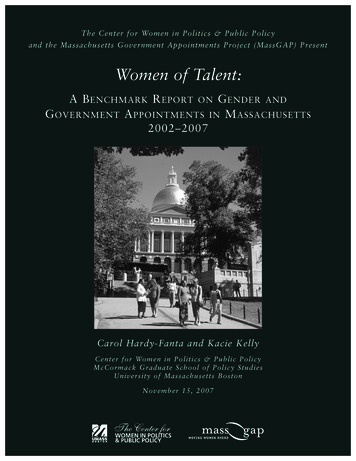
Transcription
The Center for Women in Politics & Public Policyand the Massachusetts Government Appointments Project (MassGAP) PresentWomen of Talent:A B ENCHMARK R EPORT ON G ENDER ANDG OVERNMENT A PPOINTMENTS IN M ASSACHUSETTS2002–2007Carol Hardy-Fanta and Kacie KellyCenter for Women in Politics & Public PolicyMcCormack Graduate School of Policy StudiesUniversity of Massachusetts BostonNovember 15, 2007
ABOUT THE CENTER FOR WOMENIN POLITICS & PUBLIC POLICYThe mission of the McCormack Graduate School’sCenter for Women in Politics & Public Policy at theUniversity of Massachusetts Boston is to promotewomen’s leadership by providing quality education,conducting research that makes a difference inwomen’s lives, and serving as a resource for theempowerment of women from diverse communitiesacross the Commonwealth. Recognizing the talentand potential of women from every community, andguided by the urban mission of an intellectuallyvibrant and diverse university in the heart of Boston,the Center seeks to expand the involvement ofwomen in politics and their influence on policies thataffect them, their families, and their communities. TheCenter was established in 1994 with the support ofthe Massachusetts Caucus of Women Legislators; overseesa Graduate Certificate Program for Women inPolitics and Public Policy; and supports other initiativesat the McCormack Graduate School. To find out moreabout the Center and the McCormack Graduate School,or to order copies of this report, please contact the:CENTER FOR WOMEN IN POLITICS & PUBLIC POLICYJohn W. McCormack Graduate School of Policy StudiesUniversity of Massachusetts Boston100 Morrissey BoulevardBoston, Massachusetts 02125-3393Ph: 617.287.5541Fax: 617.287.5544Email: cwppp@umb.eduWeb: www.mccormack.umb.edu/cwpppABOUT MASSGAPThe Massachusetts Government AppointmentsProject (MassGAP) was founded in 2002 as a bipartisan coalition of over forty women’s groupswhose purpose is to increase the number ofwomen appointed by the new governor to seniorlevel cabinet positions, agency heads, andselected authorities and commissions in theCommonwealth. The Massachusetts Women’sPolitical Caucus is the Lead Sponsor of thiscoalition. To find out more about MassGAPcontact:MassGAPc/o Massachusetts Women’s Political Caucus11 Beacon Street, Suite 432Boston, MA 02108Ph: 617.451.9294Fax: 617.523.2292Email: info@massgap.orgWeb: www.massgap.orgOrganizations Participating in MassGAPThe Boston ClubGreater Boston Chamber of CommerceMassachusetts Commission on the Status of WomenMassachusetts Nurses AssociationNew England Women in Real EstateSouth Shore Chamber of Commerce Women’s Business ConnectionCenter for Women in Politics and Public Policy, UMass BostonWomen’s Transportation SeminarThe Alliance of Women’s Business and Professional Organizations ACKNOWLEDGMENTThe Center for Women in Politics and Public Policy andMassGAP would like to acknowledge the very importantcontribution of Donna Stewartson to the project andthis report. Ms. Stewartson served as a MassGAPSteering Committee member and liaison to its EducationTaskforce. She assisted in formulating strategies toattract “women of talent” for MassGAP’s resume bankand to nurture relationships with participating organizations. Ms. Stewartson was also instrumental in gathering data for this report. Donna Stewartson is theAssociate Director of the Graduate Program for Womenin Politics and Public Policy at UMass Boston’s McCormackGraduate School of Policy Studies. She is a respectedcommunity organizer dedicated to increasing therepresentation of women and people of color ingovernment. She received her MBA from SimmonsGraduate School of Management and a BA in PoliticalScience from Boston College.The American Association of University Women of MassachusettsAssociation of Women in ScienceBerkshire County Commission on the Status of WomenBig Sister Association of Greater BostonBoston University School of Social WorkBoston Women’s CommissionCambridge Commission on the Status of WomenThe Center for Women and EnterpriseThe Commonwealth InstituteConference of Minority Transportation OfficialsCrittenton Women’s UnionLatino Professional NetworkMassNOWNational Black MBA AssociationNew England Women Business OwnersPlanned Parenthood League of MassachusettsService Employees International Union Local 509Simmons Institute for Leadership and ChangeSisters in DevelopmentSomerville Women’s CommissionSouth Shore Women’s Business NetworkUMass Boston Women’s CenterUMass Dartmouth Women’s Resource CenterWomen’s Bar AssociationWomen Entrepreneurs in Science and TechnologyThe Women’s Environmental NetworkWomen in Film & Video/New EnglandWomen in the Building TradesWomen in World TradeYWCA of Central Massachusetts
INTRODUCTIONDespite the high educational and occupationalattainment—and considerable talent—of women inMassachusetts, the state ranks just 22nd in the nationon women's overall share of top executive, legislative, and judicial posts, compared to their share ofthe population.1Among the many reasons given for increasing thenumber of women in leadership positions in state government, fairness and equity typically stand out. Afterall, women make up more than half (52 percent) of thepopulation in the Commonwealth. Should they not holdat least half of the top positions in government?Perhaps even more compelling is a perspective gaining currency here and across the nation: the Commonwealth of Massachusetts—as in other states wherewomen’s educational and occupational attainment isparticularly high2—cannot afford to miss out on thetalent that women would add to state governmentshould their presence in leadership positions increase.The Massachusetts Government Appointments Project (MassGAP) was co-founded in 2002 by the Massachusetts Women’s Political Caucus (MWPC) and theAlliance of Women’s Business and Professional Organizations as a bipartisan coalition of women’s groups. (Seefront cover for a list of participating organizations.)MassGAP’s purpose was to increase the number ofwomen in senior-level appointed positions in state government in order to achieve fair representation forwomen. MassGAP was envisioned as a diverse group ofwomen reflecting broad-based participation by womenof all races, ethnic backgrounds, geographies, politicalparties, and sexual orientation.Between January 2002 and July 2004, 42 percent ofthe new gubernatorial appointments made by GovernorMitt Romney were women. Massachusetts was widelyrecognized for that achievement—and MassGAPreceived considerable credit.With a new election approaching, MassGAP askedthe Center for Women in Politics and Public Policy atUMass Boston’s McCormack Graduate School to undertake a study of overall gender diversity in gubernatorialappointments at four points in time: prior to the 2002gubernatorial election; in July 2004, following the majorappointments made by the Romney administration; inNovember 2006, at the end of the Romney administration; and in 2007, after the first nine months of thePatrick administration.3The goals of this study were to (1) calculate the percentage of women holding senior-level positions in stategovernment at these four points in time; (2) analyze thedistribution of appointments by type of position andexecutive office; (3) provide possible explanations for thestatus of women’s representation in these positions; and(4) offer recommendations that will serve to promotethe appointment of more talented women into positionsof leadership in the Commonwealth.About the StudyThe original dataset created by MassGAP in September 2002 (at the end of the Swift administration) classified senior-level individuals into the following categories:secretary of an executive office; agency head (includingcommissioners/deputy commissioners, undersecretaries,executive directors, etc.) of a state agency/department;and chairs, vice chairs and members of selectedboards/commissions.MassGAP provided the Center for Women in Politicsand Public Policy with the names of individuals holdinggubernatorial appointments to 137 positions for the2002 and 2004 time periods; the Center for Women inPolitics and Public Policy gathered data on gender forthe same positions in fall 2006 and September 2007 bycontacting each executive office, agency, and/orboard/commission directly.*It is important to keep in mind that the data do notinclude staff positions such as Press Secretary, Chief ofStaff, General Counsel and the like. While these areimportant positions, we wanted to capture appointedpositions with direct line responsibility—positions that,traditionally, have had lower levels of representation bywomen. Furthermore, we are aware that, at variouspoints in time, the titles and levels of positions havechanged; after Governor Patrick took office in 2007, forexample, what was formerly the Department of Laborwas elevated to the Executive Office of Labor and Workforce Development, with a Secretary rather than anExecutive Director.Table 1 shows the breakdown of positions includedin our analysis. Please see the Appendix at the end ofthis report for a full listing of the positions studied aswell as their classification by type of position.Table 1. Positions Included in Study, by Type, 2007 (N 135*)TypeSecretaryAgency HeadBoard/CommissionN95571*Note: Data are as of September 13, 2007; because of a number of vacancies andthe elevation of one position to the level of secretary, the number of positions in2007 is 135, not the 137 available for analysis in 2002–2006).1
MAJOR FINDINGSWomen’s Representation in Senior-LevelAppointments over TimeFigure 1 demonstrates the gender differences inappointments at three points in time: those made bythe Romney administration during the initial responseto the MassGAP initiative (2002 to 2004), during thesecond half of the Romney administration (20042006), and during the first nine months of the Patrickadministration. Highlights include the following: Between January 2002 and July 2004, 14 (42percent) of Governor Romney’s first 33 appointments to senior-level positions were women. From 2004 to 2006, however, women made upjust 25 percent of the 64 new appointmentsmade by Governor Romney.From January 2007, when Governor Patrick tookoffice, to September 13, 2007, when data collection concluded, he had made 60 new appointments. Twenty-seven (45 percent) of these werewomen. Just prior to the 2002 election, women made up30 percent of the senior appointees in our sample. The percentage stayed about the same duringGovernor Romney’s first wave of appointments,but declined between July 2004 and mid-November 2006. Women made noticeable gains in 2007 afterGovernor Patrick’s first wave of appointments:women currently hold 33.6 percent of senior-levelpositions.FIGURE 2Women as Percent of Total Senior-LevelPositions, 2002-2007 (N 135)FIGURE 12002-2004(N 33)(N 135)4035Percent Women Figure 2 shows the status of women’s representation at the four points in time (September 2002, July2004, mid-November 2006, and September 2007) ofthis study. One can see that:3030.029.72533.627.620151050Female(N 14)42%Sept. 2002Male(N 18)58%Jul. 2004Nov. 2006Sept. 2007Source: MassGAP, the Center for Women in Politics andPublic Policy, and the Office of the GovernorWomen’s Representation over Time, by Levelof Appointment2004-2006(N 64)Female(N 16)25%Male(N 48)75%Jan. 2007 - Sept. 2007(N 60)Female(N 27)45% Women’s representation among the secretariesof executive offices changed from 12.5 percent(1 out of 8) in 2002, to 37.5 percent (3 out of 8)in 2004, back to just 12.5 percent (1 out of 8)in 2006, and rose to 33.3 percent (3 out of 9)in 2007.4 Changes at the level of agency head were gradual but showed an overall increase: from 25.9percent in 2002 to 41.8 percent in 2007.Male(N 33)55%Source: MassGAP, the Center for Women in Politics andPublic Policy, and the Office of the Governor2Another measure of progress in women’s representation in positions filled through gubernatorialappointment is the percentage of senior-level positions (i.e., secretaries of executive offices and agencyheads) compared to seats on boards or commissions.Figure 3 shows that the gender of senior-levelappointed officials in our sample varied considerablyby level and year.
In contrast, the percentage of women holdingappointed positions on boards and commissions dropped gradually from 35.3 percent in2002 to 23.9 percent in 2006, but then roseslightly again in 2007 to 27.1 percent.Leslie Kirwan as Secretary of Administration andFinance marks the first time a woman has servedin this highly influential position. Women held about one in five positions in theExecutive Office of Energy and EnvironmentalAffairs (then called the Executive Office of Environmental Affairs) before the 2002 election—and, again, in 2006. There was a slight increase(to 33 percent) in July 2004 during Romney’s firstwave of appointments and an even greaterincrease (to 50 percent) in 2007, during Patrick’sfirst wave of appointments. Finally, from 2002 to 2007, appointments ofwomen to the more traditionally “male” officesof Public Safety and Transportation/Constructionare generally the lowest. Public Safety ranges from 14 percent at the lowest in 2002 to 36 percent at the highest in 2006,and is currently at 21 percent for Patrick appointments. The Executive Office of Transportation and PublicWorks (“TransConst.“5 in Figure 4) ranged from24 percent in 2002 to 12 percent in 2006, with aslight increase in 2007 to 19 percent. In 2007, women saw the greatest increase in theoffices of Environmental Affairs and Health andHuman Services (including Elder Affairs), withfemale appointments rising to 50 percent.FIGURE 3Women Appointed Officials, by Level, 2002-2007(N 135)(N 135)60Jul. 2004Nov. 2006Sept. 20075023.927.12012.512.5100SecretaryAgency HeadBoard/CommissionSource: MassGAP, the Center for Women in Politics andPublic Policy, and the Office of the GovernorWomen’s Representation over Time, byExecutive Office Women, on average, held about a third of theappointed positions in the Executive Office ofAdministration and Finance and the Office ofEducation during the 2002-2007 time period.The offices in the category labeled “Econ.” in Figure 4 (which includes Labor/Economic and Workforce Development, Consumer Affairs, Housingand Insurance), showed higher percentages ofwomen—ranging from 46 percent in 2002 to anall-time high of 54 percent in 2004—before dropping to 31 percent at the end of the Romneyadministration in 2006. At this point in thePatrick administration, women hold 29 percent ofsenior-level positions in these executive offices.We should point out, of course, that SuzanneBump made history as the first female Secretaryof the newly created, cabinet-level Secretary ofthe Executive Office of Labor and WorkforceDevelopment. In addition, the appointment ofFIGURE 4Women in Appointed Positions, by Executive Office,2002-2007 (N 135)605440504650353531504131302932 32333330 3122203036332320142124151912100Admin. Percent WomenSimilar to position level, Figure 4 demonstratesthat the degree of representation by women variedby the executive offices in which they served over thefour time periods.Sept. 2002Jul. 2004Nov. 30.234.5Environ.33.3Educ.41.837.540Econ.Percent WomenSept. 2002Sept. 2007Source: MassGAP, the Center for Women in Politics andPublic Policy, and the Office of the Governor3
EXPLAINING CHANGES INWOMEN’S APPOINTMENTSrolled over. Making more appointments increases theopportunities for women.Does Leadership Mean Positive Change ForMassGAP’s early impact—with then-GovernorWomen?Romney selecting women as 42 percent of his newInitial assessment of Patrick’s appointments duringappointments—was promising. However, the analysisthefirst nine months in office reveals an overall gainin this report suggests that subsequent appointmentsfor women. The 45 percent of newdid not reflect a continued comappointments filled by Governormitment to the selection ofPatrick is even higher than thewomen for high-level posts.It is essential for talented women torecord-setting 42 percent of GovThe net result over the fourernor Romney in 2002.points in time suggests thatserve in senior positions in state govThe overall gain also reprewomen’s gains between 2002 andernment. The entire Commonwealthsents a needed correction to the2006 were elusive: women at thebenefits from the diversity of opin2006 low of just 25 percent ofend of the Romney administrationions and experiences that womennew appointments made ofdid not hold a higher percentage ofleaders bring to the table.women. Further, the increase insenior-level positions than when heJesse Mermell, Executive Directorsecretary-level appointments fromtook office (see Figure 2 above).Massachusetts Women's Political2006 to 2007 is particularly sigWhat explains this fact?Caucusnificant given the importance ofFirst, even during the first timethese high-ranking positions.period (September 2002 throughFinally, of particular note is the impact of a dediJuly 2004), the majority (61 percent) of new appointcated pattern of appointing women on the “bottomments did not change the gender of the appointee.line.” While women still do not fill senior-levelOur analysis shows that a woman was appointed to aappointed positions in proportion to their 50-plusposition previously held by a woman in 24 percent ofpercent share of the population, their representationthe cases, and Governor Romney appointed a man toat this level of government is the highest it has been.a position already held by a man in 37 percent ofThey now hold a third (33.6 percent) of thesecases.appointed positions.Second, newly appointed women replaced men inHowever, it should be noted that the Office of the18 percent of the positions. However, in 21 percentGovernor is still in the process of making appointof the cases, a man replaced a woman. It is this latterments. It will be important to sustain this initialpoint that helps explain the lack of overall growth inprogress over the coming years as appointments conwomen’s representation in top positions: men replacedtinue to be made.more women than women replaced men.6Third, the pattern shown in 2004 was repeated in2006, clearly indicating that gains are difficult to attainUTURE ONSIDERATIONSbecause women are appointed to replace women,This study serves not only as an analysis ofmen replace men, and when there is a change in sex,women’s representation in senior government posimore men replace women than women replace men.tions filled through gubernatorial appointment atFinally, it should be noted that many factors influfour points in time but also as the first opportunity toence a governor’s appointment practices. Many officompare gubernatorial appointments at similar pointscials hold appointments with set terms; the Governorin time in different administrations. Using the dataat times may have no control over appointments togathering system that is now in place, it is possible tothose positions. At the same time, 84 (66 percent) ofcontinue to track the appointments being made byappointed officials in office in 2002 were “rolled/heldGovernor Deval Patrick during his term—and to trackover” in July 2004. Between 2004 and 2006, 70 posiappointments made by future governors. These findtions (52 percent) fell into this category, and for theings continue to guide MassGAP and the coalition ofnine-month period in 2007 in the Patrick administrawomen’s organizations that has worked hard totion included in our analysis, 71 (53 percent) wereF4C
increase women’s representation. The result of theseefforts has meant a greater share of the seats at thetables where policies are decided.Recommendations for the future include thefollowing:1. Senior-level positions in state government in theCommonwealth of Massachusetts are still predominantly occupied by men. There is a continued needfor fair representation of women in these positions.2. There also is a need to maintain an ongoingpipeline and visibility with respect to the diversityof gubernatorial appointments after the first waveof appointments is made by any administration.The Romney administration’s track record for gender diversity in appointments was highest duringhis first year and a half in office; it fell off considerably after July 2004. Continued efforts should bemade to monitor administrations throughout thefull course of a governor’s term.increase women’s representation in senior-levelappointed positions. The data show that themajority of appointments are “rollovers” where nonew appointment is made. MassGAP has identifiedmany talented women ready to be appointed, andprogress towards gender equality will only beachieved by exercising that power.5. It is essential to use the benchmark established bythis report to build upon the early promise—andrecent progress—in women’s representation at thesenior levels of government. The Commonwealth’sfuture depends on many factors—fully utilizing thetalents of women is among the most important.3. Gaining greater representation by women in senior-level positions cannot occur unless there aremore “male to female” appointments.4. There should be a more concerted effort to use thepower of appointment to make changes thatNOTES1Source: “Women in State Policy Leadership, 1998–2005: An Analysis of Slow and Uneven Progress.” A Report of the Center forWomen in Government & Civil Society, University at Albany, State University of New York (Winter 2006). Downloaded fromhttp://www.cwig.albany.edu/APMSG2006.htm on 25 October 2007.2According to the 2000 U.S. Census, in the state of Massachusetts, 44% of women between the ages of 25 and 34 have a bachelor’sdegree or higher, compared to 39% of men. For those between the ages of 35 and 44, 37% of women compared to 36% of menhave these levels of educational attainment. This is significantly higher than the national average, which is just 29% for women (and26% for men) between the ages of 25 and 34; there is no difference nationally between women and men for those 35 to 44 years ofage. (Source: U.S. Census Quick Table “QT-P20. Educational Attainment by Sex: 2000.” Downloaded fromhttp://factfinder.census.gov/servlet/QTTable? bm y&-context qt&-Tables (‘DEC 2000 SFAIAN QTP20’)&qr name DEC 2000 SFAIAN QTP20&-ds name DEC 2000 SFAIAN&-CONTEXT qt&-tree id 406&-redoLog true& caller geoselect&-geo id 01000US&-geo id 04000US25&-search results 01000US&-format &- lang en on 25 October 2007.3Data for 2006 were collected between 7 September 2006 and 30 November 2006; data for 2007 are current as of 13 September 2007.4As is true whenever the numbers are very small, a small change from one category to another can produce very large changes in thepercentage. Also, the actual number of secretarial appointments increased from 8 to 9 when Governor Patrick took office.5Note: We are aware that the new title is Executive Office of Transportation and Public Works; we have chosen to use the older versionof this office because the older title covered a longer time span.6Of the 88 other positions over which the governor had control where prior appointees remained in office, 25% of these were womenand 74% were men. Of the positions that were eliminated or open, women had held two, and a man held one.7Includes Elder Affairs.8Formerly Executive Office of Transportation and Construction.5
APPENDIXList of Positions and Departments, by Executive OfficeExecutive Office(s)Administration and FinancePositionDepartmentSecretaryExecutive Office of Administration & FinanceCommissionerDepartment of RevenueCommissionerDivision of Capital Asset Management & MaintenanceCommissionerDivision of InsuranceBudget DirectorFiscal Affairs Division (formerly Budget Bureau)Executive DirectorGroup Insurance CommissionPersonnel AdministratorHuman Resources Division - now Director of Human Resources Chief Human Resources OfficerDirector/CIOInformation Technology DivisionDirectorOffice of Diversity and Equal Opportunity (formerly Office ofAffirmative Action)ControllerOffice of the ComptrollerCommissionerVeteran’s ServicesChairAppellate Tax BoardChairmanCivil Service CommissionChairmanMassachusetts Commission Against Discrimination BoardChairMassachusetts Commission Against Discrimination BoardMemberMassachusetts Commission Against Discrimination BoardChairMassachusetts Judicial Nominating CommissionConsumer Affairs/Housingand partment of Labor & Workforce DevelopmentDirectorDepartment of Labor & Workforce DevelopmentChiefOffice for Commonwealth Development (formerly Mass.Development)SecretaryOffice of Housing & Economic DevelopmentExecutive DirectorBoard of Registration in MedicineDirectorDepartment of Professional LicensureCommissionerDivision of BanksDirectorHousing & Community DevelopmentExecutive DirectorMassHousing (formerly Mass. Housing Finance Agency)DirectorOffice of Consumer Affairs & Business Regulations OfficeExecutive DirectorOffice of Travel & TourismDeputy DirectorStandards DivisionChairmanAlcoholic Beverages Control Commission (under Treasurer’s review)ChairmanLabor Relations CommissionCommissionerDepartment of Education (DOE)ChairBoard of Higher EducationMemberBoard of Higher EducationMemberBoard of Higher EducationMemberBoard of Higher EducationMemberBoard of Higher EducationMemberBoard of Higher EducationMemberBoard of Higher EducationMemberBoard of Higher EducationMemberBoard of Higher EducationVice ChairBoard of Higher EducationChairMassachusetts Education Financing Authority BoardMemberMassachusetts Education Financing Authority BoardMemberMassachusetts Education Financing Authority BoardMemberMassachusetts Education Financing Authority Board
APPENDIX(cont.)List of Positions and Departments, by Executive OfficeExecutive Office(s)Energy/Environmental AffairsHealth and Human Services7PositionDepartmentMemberMassachusetts Education Financing Authority BoardMemberMassachusetts Education Financing Authority BoardMemberMassachusetts Education Financing Authority BoardVice ChairMassachusetts Education Financing Authority BoardVice ChairMassachusetts Education Financing Authority BoardChairmanState Board of EducationMemberState Board of EducationMemberState Board of EducationMemberState Board of EducationMemberState Board of EducationMemberState Board of EducationMemberState Board of EducationMemberState Board of EducationVice ChairState Board of EducationVice ChairState Board of EducationSecretaryExecutive Office of Energy & Environmental AffairsExecutive DirectorCoastal Zone ManagementCommissionerDepartment of Conservation and Recreation (formerly MetropolitanDistrict Commission & Department of Environmental Management)CommissionerDepartment of Environmental ProtectionCommissionerDepartment of Food & AgricultureCommissionerDepartment of Fisheries, Wildlife & Environmental Law EnforcementExecutive DirectorMassachusetts Water Resources Authority (MWRA) BoardChairMassachusetts Water Resources Authority (MWRA) BoardDirector of ChairmenMassachusetts Water Resources Authority (MWRA) BoardMemberMassachusetts Water Resources Authority (MWRA) BoardSecretaryExecutive Office of Health & Human ServicesCommissionerDepartment of Mental HealthCommissionerDepartment of Mental RetardationCommissionerDepartment of Public HealthCommissionerDepartment of Social ServicesCommissionerDepartment of Transitional AssistanceCommissionerDepartment of Youth ServicesCommissionerDivision of Healthcare Finance & PolicySecretaryExecutive Office of Elder AffairsExecutive DirectorHealth and Education Facilities AuthorityCommissionerMass. Commission for the BlindCommissionerMass. Commission for the Deaf & Hard of HearingCommissionerMass. Rehabilitation CommissionDirectorOffice for Refugees and ImmigrantsCommissionerOffice of Early Education and Care (formerly Child Care)DirectorOffice of MedicaidMemberHealth and Education Facilities AuthorityMemberHealth and Education Facilities AuthorityMemberHealth and Education Facilities AuthorityMemberHealth and Education Facilities AuthorityMemberHealth and Education Facilities AuthorityMemberHealth and Education Facilities AuthorityMemberHealth and Education Facilities AuthorityMemberHealth and Education Facilities Authority7
APPENDIX(cont.)List of Positions and Departments, by Executive OfficeExecutive Office(s)Public SafetyTransportation & Public Works8PositionDepartmentSecretaryExecutive Office of Public SafetyExecutive DirectorArchitectural Access BoardCommissionerDepartment of CorrectionState Fire MarshallDepartment of Fire ServicesCommissionerDepartment of Public SafetyExecutive DirectorGovernor’s Highway Safety BureauDirectorMass. Emergency Management Agency (MEMA)Brigadier GeneralMass. National GuardRegistrarMotor Vehicles RegistryExecutive DirectorMunicipal Police Training Committee (MPTC)SuperintendentState Police DepartmentAssistant CommissionerSubstance Abuse ServicesChairBoard of Building Regulations & StandardsChairParole BoardSecretaryExecutive Office of Transportation & Public Works8CommissionerMassachusetts Highway DepartmentDeputy CommissionerMassachusetts Highway DepartmentExecutive DirectorMassachusetts Turnpike AuthorityGeneral ManagerMBTACommission ChairAeronautics CommissionCommission MemberAeronautics CommissionCommission MemberAeronautics CommissionVice ChairAeronautics CommissionChairMassachusetts Turnpike Authority BoardVice-ChairMassachusetts Turnpike Authority BoardChairMASSPORT Board of DirectorsMemberMASSPORT Board of DirectorsMemberMASSPORT Board of DirectorsMemberMASSPORT Board of DirectorsMemberMASSPORT Board of DirectorsMemberMASSPORT Board of DirectorsMemberMASSPORT Board of DirectorsMemberMBTA BoardMemberMBTA BoardMemberMBTA BoardMemberMBTA BoardMemberMBTA BoardMemberMBTA BoardMemberMBTA BoardMemberMBTA Board
ABOUT THE AUTHORSCarol Hardy-Fanta, PhD, is Director of theCenter for Women in Politics and PublicPolicy at UMass Boston’s John W.McCormack Graduate School of PolicyStudies. She rece
about the Center and the McCormack Graduate School, or to order copies of this report, please contact the: CENTER FOR WOMEN IN POLITICS & PUBLIC POLICY John W. McCormack Graduate School of Policy Studies University of Massachusetts Boston 100 Morrissey Boulevard Boston, Massachusetts 02125-3393 Ph: 617.287.5541 Fax: 617.287.5544 Email: cwppp .

